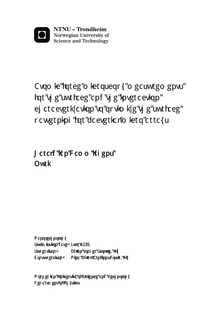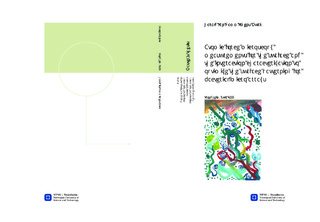| dc.description.abstract | This Master project was done in the Department of Physics at NTNU in the spring2013. The project focus on the optimization of micro patterning techniques to producemicro arrays for single bacterial cell studies. The micro arrays are produced by con-trolling the surface chemistry and the spatial resolution of the two dimensional (2D)patterns in the micro or nanometer range. Such micro arrays of bacteria consist of ahigh number of spots of bacterial adhering molecules on a at surface having a size that allows a single bacteria to be immobilized. Patterned surfaces that allows controlled and patterned adhesion of single bacteria can serve in a great number of applications.Studies of bacterial interactions are important to understand the mechanisms behindformation of biolms, that is highly relevant for e.g. implants of medical devices. Un-derstanding the bacterial interactions in heterogeneous populations are also relevant inthe development of homogeneous populations that are engineered to respond to certainpatterns in the environment. Micro arrays of homogeneous bacterial populations couldthen also function as e.g. cell based sensor device to detect pathogenic agents or toxins. It has also been an increasing interest for making single cell arrays of motile bacteria to be used as biomotors for micro or nanoscale systems.This project explores the application of soft lithography for the preparation of patterned supports designed for the monitoring of bacterial population at the individual bacterial cell level. The surface functionalization are optimized in order to allow ecient transfer of anchoring molecules, as well a strong and stable bacterial immobilization, combined with high bacterial viability. The optimization are performed by measuring the interactions between the bacteria DH5alfa and bacterial adhesive or repulsive surfaces with atomic force microscope (AFM). The bacterial interactions with glass, bovine serum albumine (BSA), poly-L-lysine (PLL), polydopamine (PDA), and Cell-Tak surfaces are assessed to find proper adhesive or repulsive molecules for the bacterial micro arrays. BSA are dened as bacterial repulsive molecule, while PLL, PDA, and Cell-Tak are characterized as bacterial adhesive molecules.PLL and Cell-Tak were incubated on the glass surfaces while PDA and BSA were printedon the glass surface by the use of a flat poly(dimethysiloxane) (PDMS) stamp. The bac-terial interactions with glass, BSA, PLL, PDA and Cell-Tak surfaces were found to havemean rupture forces of 0.13nN, 0.28nN, 1.22nN, 1.73nN, and 1.91nN, respectively. Themean rupture lengths were found to be 32nm, 24nm, 58nm, 65nm, and 108nm for glass,BSA, PLL, PDA and Cell-Tak surfaces, respectively. The immobilization of bacteriaon the AFM tip were validated before and after AFM experiments by the use of fluorescence microscopy and scanning electron microscopy (SEM). The bacteria DH5alfashow to interact stronger with PLL, PDA and Cell-Tak surfaces than for glass and BSAsurfaces. The bacterial interactions with Cell-Tak and PDA surfaces show to exhibitmean rupture forces that is higher than the mean rupture force for PLL surfaces. Thebacterial interactions with Cell-Tak surfaces show also to have a mean rupture lengthvalue that is close to or larger than twice the mean rupture length value of bacterialinteractions with glass, BSA, PDA, and PLL surfaces. PDA or Cell-Tak can then bedened optimal bacterial adhesive layers in bacterial micro arrays because of their larger mean rupture forces and lengths values than the PLL values. BSA can be characterized as bacterial inert or repulsive layer because of its small mean rupture force and length. The bacterial viability on PDA or Cell-Tak surfaces can be assessed by the use of the LIVE/DEAD Baclight Viablility Kit (Invitrogen, kit L7012) supplied by the company Life Technologies.Since a cluster of bacterias are interacting with the bacterial adhesive or repulsive surfaces, it is unknown if the bacterial interactions with surfaces are dependent on thenumber of bacterias being immobilized on the tip. A higher accuracy of the AFM forcemeasurements of the bacterial interactions with surfaces can be obtained by modifyingthe AFM tip with a colloidal glass bead as demonstrated by Beaussert et al. (Beaus-sart et al. 2013). This way of immobilizing and validating the presence of bacterias onthe AFM tip minimize time consuming procedures of control measurements and SEMinvestigations of the AFM tip after the force measurements. The use of a simple, lesstime consuming and accurate AFM technique for bacterial force measurements wouldopen up for the possibility to explore the bacterial interaction with the bacterial adhesive or repulsive surfaces as a function of the liquid medium, contact time or loading rate.Lastly, the bacterial interactions with the Cell-Tak surface show to have extended rup-ture lengths with multiple force peaks obtained that indicates stretching and unfoldingof the Cell-Tak proteins or the bacterial cell surface proteins. The combination of non-covalent interactions behind this bacterial adhesion is not clear, but it is assumed toinvolve electrostatic and hydrophobic interactions. As the AFM images shows that theCell-Tak layer is non-uniform, further force measurements of bacterial interactions withCell-Tak surfaces are suggested to be investigated. The investigation of bacterial in-teractions with the Cell-Tak surface should also consist of using alternative preparation methods of Cell-Tak proteins glass surfaces as micro contact printing or other incubation methods. To further optimize bacterial micro arrays and to investigate the factors involved in bacterial adhesion to bacterial adhesive or repulsive surfaces, characterization techniques like PeakForce QNM AFM mode supplied by the company Bruker, mapping using accumulated probe trajectories (MAPT) technique, or bacterial AFM forcemeasurements would have the possibility to facilitate such investigations. | nb_NO |

